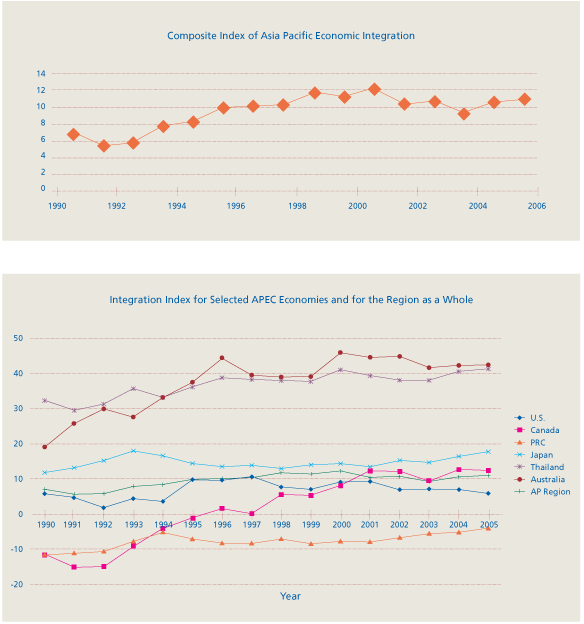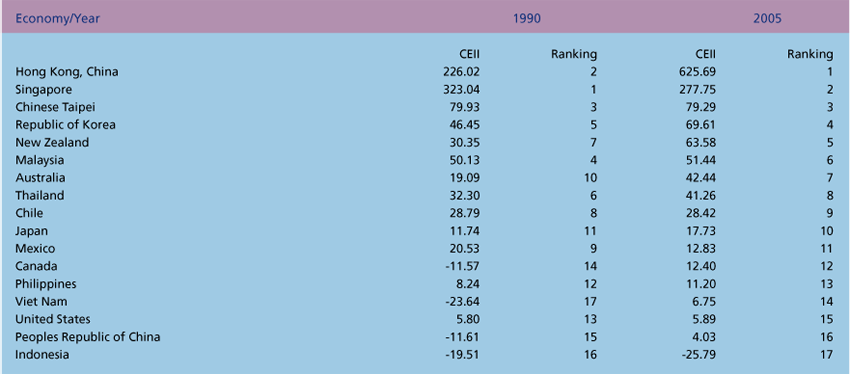A Composite Index of Economic Integration in the Asia Pacific
As the Asia Pacific Economic Cooperation (APEC) forum approaches its 20th anniversary in 2009, there will be renewed discussion on the accomplishments of the organization over the last two decades. From inception, APEC has focused on economic issues, with particular emphasis on the Trade and Investment Liberalization and Facilitation (TILF) agenda. The celebrated 1994 Bogor target of “free and open trade” by 2010 for developed member economies (2020 for developing members) has long served as a raison d’etre for APEC. Eschewing formal negotiations and binding agreements, APEC’s approach to trade and investment liberalization has been based on “concerted unilateral liberalization” – the belief that member economies acting on self interest would reduce border barriers unilaterally, and that APEC peer pressure would result in even more ambitious acts of “concerted” liberalization. APEC’s vision of trade liberalization has also been premised on “open regionalism” – the idea that while members would liberalize trade and investment within the region, these market-opening measures would not be at the expense of non-members.
“Concerted unilateral liberalization” and “open regionalism” have turned out largely to be empty slogans. There has been limited progress on Asia Pacific-wide liberalization measures that go beyond the Uruguay Round commitments. Likewise, the proliferation of preferential trade agreements in the region suggests that while APEC members are interested in greater market access, they are selective in their choice of trade and investment partners, and quite ready to exercise discrimination against fellow APEC members as well as non-APEC members. As a result, the evolution of trade and investment integration in the region has been complicated, with trade and investment flows influenced both by “natural” comparative advantage as well as by “distortions” of domestic policy and by bilateral/regional economic agreements.
One of the tensions in APEC is the trans-Pacific nature of the organization. The creation of APEC was in large part motivated by a desire to not “draw a line down the Pacific”. Since 1998, however, there has been growing interest in Asia-only free trade agreements as well as East Asia and Asia-wide institutions that explicitly leave out the other side of the Pacific. The North and South American members of APEC have also pursued ideas of hemispheric integration, particularly the idea of a FreeTrade Area of the Americas, albeit with little success. It is not clear that Asia-only agreements are in fact diverting trade and investment away from North and South American members of APEC or indeed that future trade agreements will place less emphasis on trans-Pacific access to North America as they currently place on intra-Asia trade. In any case, the APEC “project” is predicated on the idea of increasing economic integration across the region – covering both sides of the Pacific. Any measure of the organization’s success, therefore, would require an assessment of whether the region has in fact become more integrated.
In this context, the Pacific Economic Cooperation Council (PECC) has developed a set of indicators to measure the extent of economic integration in the Asia Pacific region. Using data from 17 member economies of APEC, the composite index provides a measure of economic integration for the region as a whole, as well as for individual economies, from 1990 to 2005. This index will be launched as part of PECC’s 2008 State of the Region Report to be released at the APEC Leaders’ Meeting in Lima in November 2008.
Major findings of the Composite Index of Asia Pacific Economic Integration 2008 include:
- The Asia Pacific region as a whole is more integrated at the end of 2005 than it was in 1990. There was a steady upward trend in the economic integration of the region from 1991 through 2000. Following the bursting of the IT bubble in 2001, regional integration declined or was flat for the next three years but picked up again in 2004 and 2005.
- Hong Kong is the economy most highly integrated with the Asia Pacific region, followed by Singapore and Chinese Taipei. These three economies have held the top positions for most of the period covered by the index.
- The least integrated economy in 2005 was Indonesia, followed by China and the United States. The US index was volatile over the period, with the 2005 figure only slightly higher than in 1990. The US ranking has fallen by three places since 1997.
- The economies which increased their integration with the Asia Pacific by the greatest amount between 1990 and 2005 were Hong Kong, New Zealand, Vietnam, Canada, and Australia.
- Five economies were less integrated with the Asia Pacific region in 2005 than in 1990: Chile, Chinese Taipei, Indonesia, Mexico, and Singapore.

The composite index of economic integration is based on a combination of measures that on the one hand looks at the extent to which the reference economies are becoming more alike in their economic characteristics (so-called “convergence” measures) and on the other hand at the relative importance of trade, investment and human flows within the region compared to economic relations with the rest of the world. The convergence measures are premised on the notion that integration will lead to greater uniformity among the economies. Accordingly, more trade and investment among regional partners may not translate into a higher score on the integration index if at the same time the partners are diverging in terms of income, education, life expectancy, urbanization, and economic structure. Furthermore, since the trade, investment, and tourism measures are calculated relative to global transactions, the index will rise for a given economy only if that economy’s share of trade/ investment is growing relative to total trade and investment.
An important feature of the index is that it excludes trade and investment flows among geographically contiguous subregional trade agreements, namely NAFTA, the ASEAN free trade agreement, and Australia-New Zealand Closer Economic Relations. It also excludes flows within “Greater China” -- the People’s Republic, Hong Kong, and Chinese Taipei. This is to control for the effect that sub-regional flows may have on the index, whereby a very high degree of integration among say NAFTA economies could result in a falsely high measure of integration with the Asia Pacific region as a whole. In the case of Greater China, the exclusion of intraregional flows did not affect the positions of Hong Kong and Chinese Taipei at the top rankings of the index. On the other hand, the People’s Republic of China’s much lower ranking suggests that a large share of its trade and investment flows with Asia Pacific partners is with Hong Kong and Chinese Taipei, and that its share of trade and investment with countries outside of the Asia Pacific is larger than that of other economies in the region.
Caution should be exercised in the interpretation of these findings. The measures chosen for inclusion in the composite index are imperfect indicators of “convergence” and trade/investment integration. The rankings in turn should not be read normatively as “league tables” in the sense that a higher ranking is superior to a lower ranking. Indeed, a low ranking may simply indicate that an economy is more oriented globally than regionally, as is likely the case for China and the United States. Nevertheless, the change in index value for a given economy over time can be read as a measure of its changing economic orientation. The index value for the region as a whole can also be seen as a measure of closer economic ties among Asia Pacific economies and as one indicator of APEC’s success. Given that the index shows growing economic integration in the region, the very least that one can say is that the APEC project -- in its broadest ambition -- has not been in vain.
Value of Composite Economic Integration Index and Ranking of Asia Pacific Economies, 1990 and 2005

The index is constructed in two stages, with weights assigned by “Principal Components Analysis” -- which calculates the relative importance of each sub-component based on its statistical qualities – rather than by subjective assessment.
In the first stage, a convergence index is constructed to measure the dispersion of selected economic indicators among the Asia Pacific sample economies. The convergence index is a measure of whether the economies are becoming more alike as a result of closer interaction and economic development. The indicators included in the convergence index are as follows
> Real GDP per capita
> Share of non-agricultural sector in GDP
> Ratio of urban residents to total population
> Life expectancy
> Share of education expenditure in GDP
In the second stage, indicators of trade, investment, and people flows are added to the convergence index and weights are assigned, again using Principal Components Analysis, resulting in the composite index. The final (normalized) weights used in the composite index are as follows:
> Convergence index = 0.359
> Share of exports and imports to / from other Asia Pacific economies = 0.243
> Share of foreign direct investment flows to / from other Asia Pacific economies = 0.102
> Share of Asia Pacific tourist flows from other Asia Pacific economies = 0.294
The economies included in the index are all APEC members, namely Australia, Japan, Republic of Korea, People’s Republic of China, Hong Kong, Chinese Taipei, Vietnam, Thailand, Philippines, Indonesia, Singapore, Malaysia, United States of America, Canada, Mexico, Chile, and New Zealand. The stage two components exclude flows among geographically contiguous sub-regional trade agreements, namely the Association of Southeast Asian Nations Free Trade Area (AFTA), North America Free Trade Agreement (NAFTA), and Australia- New Zealand Closer Economic Relations. It also excludes flows within “Greater China”, namely the People’s Republic, Hong Kong, and Chinese Taipei.
A full description of the composite index is found in Chen, Bo and Woo, Yuen Pau (2008), A Composite Index of Economic Integration in the Asia Pacific Region, available at http://www.asiapacific.ca" www.asiapacific.ca
